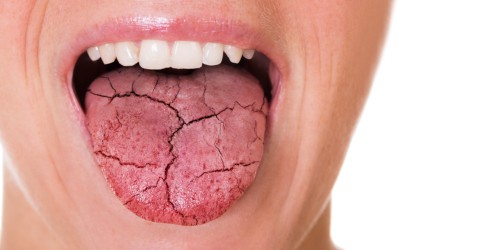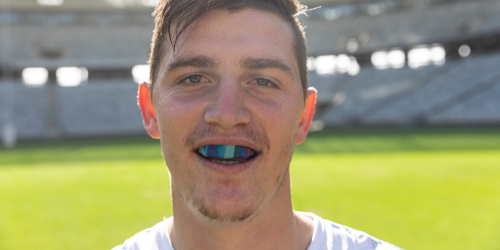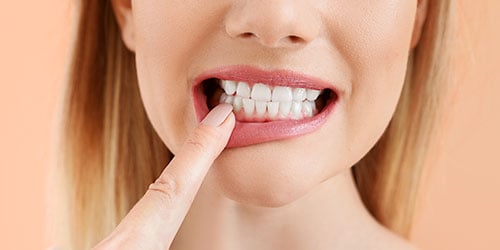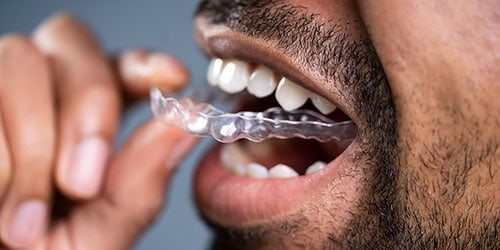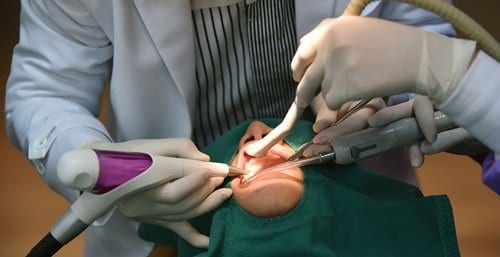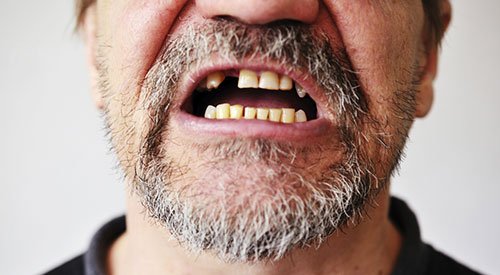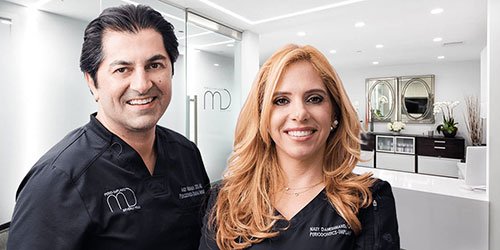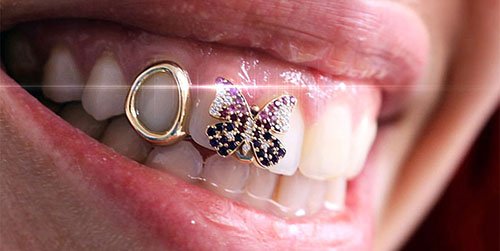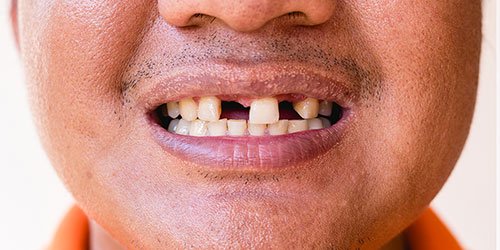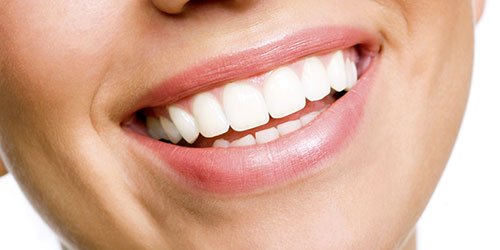A cracked tooth is not just ugly, it’s downright unhealthy
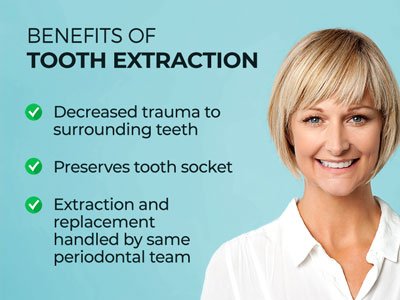
Although cracked, chipped, or fractured teeth are seen most often in children due to their high level of physical activity, the truth is that a broken tooth can happen to anyone. In our practice, we treat adults with fractured teeth due to falls, sports injuries, automotive accidents, facial blows, and simply biting on something harder than your tooth.
What causes of tooth fractures?
Tooth Trauma
Dental injuries can result from direct impact by an object or a fist.
Teeth Grinding
Over time, the strong forces exerted by your powerful jaw muscles when grinding your teeth can create hairline vertical fracture lines in your teeth (most often your molars) that can, over time, split your tooth.
Biting on something hard
Biting on hard objects, be it hard candy, nuts, ice, or raw popcorn kernels can easily crack compromised teeth.
A weakened tooth
A tooth can weaken through procedures such as fillings or a root canal and become more prone to fractures.
Repetitive impact
A repetitive force (such as those from the metal studs of lip or tongue piercings) can wear down teeth. Plus, studs can harbor dangerous bacteria, increasing the risk of infection and tooth loss.
Why you shouldn’t ignore a broken tooth
Some folks might wonder why it’s important to address a tooth fracture, no matter how small, quickly. That’s because once the structure of a tooth is compromised, it can lead to decay of the tooth. Unchecked decay can form an abscess that involves the jawbone and surrounding soft tissues. If this gets out of hand, it can cost you several teeth.
What’s more, bacterial infections of the mouth can seed your bloodstream and create much more serious health problems such as sepsis (a life-threatening blood infection), osteomyelitis (a serious bone infection involving the jaw), or cavernous sinus thrombosis (a life-threatening blood clot). Bottom line: a broken tooth cannot be ignored.


What are the different types of tooth fractures and cracks?
There’s a wide range of injuries that can happen to your tooth, spanning from shallow craze lines in your enamel to a fracture that splits your tooth and its root. Let’s review the terminology:
Chipped tooth
This is a fairly common phenomenon associated with chewing on hard objects like candy and is usually minor. If the chip is large enough to be recovered, it can sometimes be reattached to the tooth. If that’s not possible, then the gap can be filled with special bonding material. If the chip results in a jagged edge, it might be easily smoothed out with a bit of filing.
Craze lines
These are tiny vertical cracks that appear in the tooth enamel. While they don’t cause immediate danger to the health of the tooth, they can pose cosmetic problems when they become stained from coffee, tobacco, red wine, and other foods. Teeth whitening treatments and veneers can usually restore teeth with craze lines to a healthy, radiant white color.
Fractured cusp
Sometimes a crack forms at the chewing surface of a tooth causing the contact area, known as the cusp, to break off. This often occurs near a filling. Often, these fractures aren’t felt because they don’t involve the portion of the tooth (known as the pulp) where nerves and blood vessels are located. Cusp fractures are usually repaired with a new filling or, if large, by placing a crown.
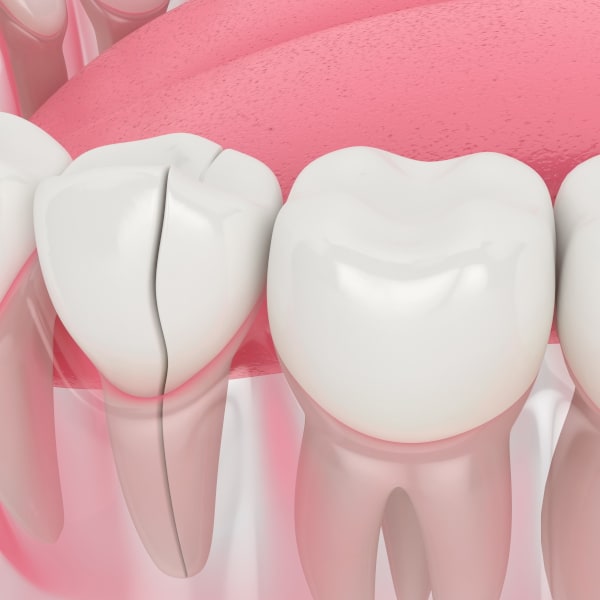
Cracked Tooth
A cracked tooth describes a vertical crack that travels from the surface of the tooth to below the gum line. Because a crack of this kind can affect the pulp of the tooth and lead to infection, the tooth may need to be extracted (removed).
Split tooth
This is a tooth that has a vertical crack that not only extends below the gum line but also separates the tooth into fracture segments. Depending on the split pattern, sometimes part of the tooth can be saved. Other times, the entire tooth must be removed.
Vertical root fracture
As its name suggests, a vertical root fracture starts in the root and moves up toward the tooth surface. Because this crack isn’t visible right away, it may go undetected for a long time. Vertical root fractures are often the result of an infection of the gum or underlying jawbone. The tooth may need to be extracted to prevent further destruction of the surrounding tissues and bone.
Near gum line fracture
When a tooth breaks off near, or just below, the gum line, our doctors can perform what is known as a crown lengthening procedure. This involves removing and/or reshaping the gum line to expose more of the tooth so that a crown can be fitted over the remaining tooth stump, thus restoring the tooth’s function.
What are symptoms that you may have a fractured tooth?
Because not all tooth fractures are visible right away, there are some symptoms that warrant further investigation with your dental practitioner.
- Pain when biting down on something
- Sensitivity to hot or cold
- Tooth pain that comes and goes for no apparent reason
- Pain that varies in intensity
When does a broken tooth require extraction?
The determining factor in deciding whether a broken tooth has to come out is the location and depth of the fracture line and how it affects the tooth structure. How deep the fracture goes will determine whether the tooth needs to come out.
Because some fractures occur below the gum line where they’re hard to see, various imaging techniques and instruments may be needed to diagnose the fracture.
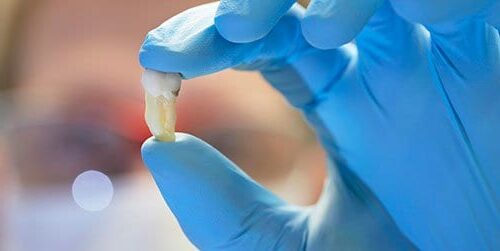
Usually, if the fracture line extends deep into the tooth root and bone, there may be no way to save the tooth, making extraction necessary. If this is the case, Drs. Moshrefi and Daneshmand use modern, gentle extraction techniques that have your comfort and safety in mind.
How is a broken tooth removed?
When some of us hear the words “tooth extraction” we envision a mad dentist with a pair of pliers yanking our tooth out without anesthesia. With today’s modern dentistry techniques, the pliers from the last century are quickly becoming museum pieces. And, if you’ve been to the dentist or periodontist any time within the last decade, you also know that local anesthesia is commonly used to ensure patient comfort.
When a fractured tooth requires extraction, there are new treatment options developed over the past 20 years. These modern techniques are designed to not only make the extraction less painful but also decrease the trauma to your tooth, the root of the tooth, and the surrounding soft tissues.
Non-traumatic tooth extraction techniques include:
Forced orthodontic eruption
This is a non-surgical approach in which a tooth is removed over a period of time. The teeth surrounding the broken tooth are bracketed and the broken tooth is subjected to constant light pressure. This causes the weakened tooth to develop multiple tooth cracks and break down gradually, making extraction relatively easy and much more comfortable.
Advantages: This technique is less invasive and preserves more bone structure, which is important for preparing the site for a replacement tooth (either a crown or an implant).
Piezosurgery
Piezosurgery is a technique that uses low-frequency ultrasound vibrations to precisely and carefully cut the bone while causing less damage to the surrounding bone and gums.
Advantages: Because this technique involves less trauma, it’s associated with less swelling and 50% less bleeding than traditional extraction methods. All of this means that your doctor can often place a restoration piece during the same session as your extraction, saving you an extra office visit.
…once the structure of a tooth is compromised, it can lead to decay of the tooth.
Are there risks associated with tooth extraction?
The risk associated with tooth extraction is determined, to a certain degree, by the approach that is used to perform the extraction. That said, below are the risks generally associated with most approaches to tooth extraction.
Bleeding
Your doctor will apply a gauze compress to the socket and instruct you to change it every few hours. Bleeding should slow down within 48 hours of the extraction. It’s important that you follow post-op instructions carefully and avoid coughing, sneezing, lifting heavy objects, or picking at the tooth socket until you form a solid blood clot (this usually takes 72 hours).
Pain and swelling
Most patients will experience pain and swelling, but it will subside over time. You can take anti-inflammatory and analgesic medications to help manage your symptoms.
Bruising
Bruising is, to a certain extent, related to the amount of force that needs to be exerted to extract the tooth. So, bruising will vary based on the extraction technique used.
Infection
There is always a risk of infection when it comes to an invasive procedure that involves opening up soft tissues to access the bone. That is why dental providers administer antibiotics as a preventative measure.
When a tooth breaks as a result of a severe bone infection originating in the underlying jaw ridge (called osteomyelitis) or a soft tissue abscess, IV antibiotic therapy may be necessary.
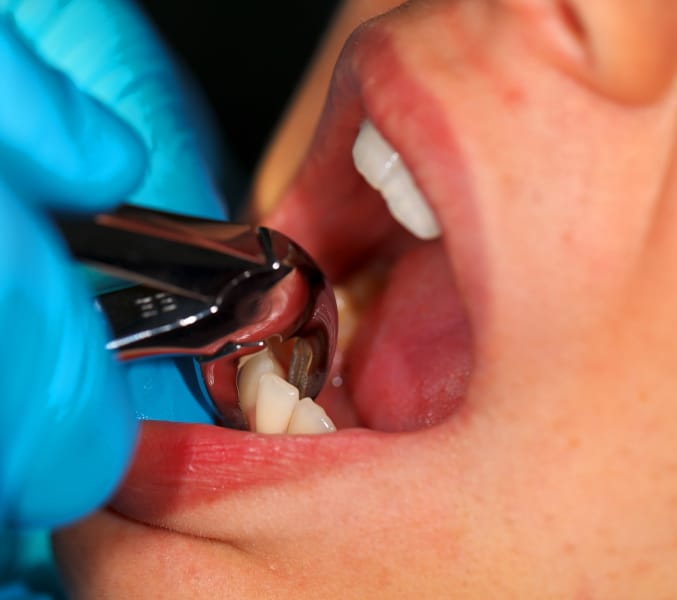
Improper tooth alignment
After tooth extraction, the resulting gap can cause the surrounding teeth to spread out, causing changes to your bite. This can result in damage to your remaining teeth and can affect their function. That’s why dental providers recommend replacing the removed tooth with a dental crown, implant, or denture.
Dry socket (aka Osteitis)
When a tooth is removed, a blood clot forms at the base of the socket where the tooth previously was. If this blood clot is dislodged before it has a chance to heal, this can lead to exposure of the supporting bone ridge and a painful condition known as osteitis or dry socket.
Maxillary sinus exposure
When the upper molars are extracted, there is a risk of creating a hole that penetrates the maxillary sinus located just above the roof of the mouth. This opening needs to be repaired in order to prevent infection. At MD Periodontics, we use state-of-the-art imaging technology to estimate the risk of sinus exposure and guide our treatment approach when extracting any upper molars.
Why choose MD Periodontics instead of a general dentist for a tooth extraction?
When it comes to doing run-of-the-mill straightforward tooth extractions, many dentists have the experience needed to extract teeth. But when it comes to performing complicated extractions that require cutting into the gum or the jawbone in order to preserve the tooth socket, a periodontist with the necessary training and experience is the best choice.
That’s because periodontists have extensive training in the structures that support the teeth, such as the gums, the roots, the periodontal ligaments, nerves, and muscles. They are uniquely qualified to repair any issues that these structures may have. What’s more, our periodontists are double board-certified in Periodontology and Implantology, meaning they have extensive experience in dental restoration and the placement of implants.
So, when they extract a tooth, they do so taking into consideration how the tooth socket will support the replacement tooth that will follow.
With the entire process from tooth extraction to tooth restoration being handled by one oral health specialist, you will benefit from a seamless, well-integrated treatment plan that will give you high quality results while saving you time and money.
Why trust MD Perio for your Periodontal care?
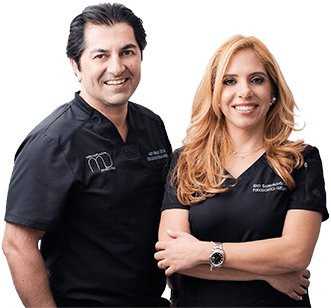
The husband-and-wife team of Dr. Abdy Moshrefi, DDS, and Dr. Nazanin Daneshmand, DDS, are two of the most trusted periodontists in Beverly Hills. Both are board-certified in periodontics and implantology and, between them, they have almost four decades of experience.
Backed by an expert team of dental professionals, MD Periodontics offers outstanding dental care in a state-of-the-art facility with a warm, welcoming family environment where our patients are truly treated like family.
To schedule a consultation, click here or call us at (310) 859-9449. Your smile will thank you!
We are conveniently located to patients throughout Southern California and the Los Angeles area. Our Beverly Hills office is conveniently located near West Los Angeles, Culver City, West Hollywood, Downtown Los Angeles, Marina del Rey, Pacific Palisades, Malibu, Manhattan Beach, Sherman Oaks, and Encino.
 (310) 859-9449
(310) 859-9449 Tooth Fractures
Tooth Fractures
 or call us at
or call us at 
















